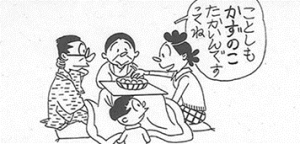Kotatsu and Hibachi
Yoshie Doi
 Works by Ukiyo-e artist Kunimasa Utagawa during the Edo period |
 Works by Ukiyo-e artist Kunimasa Utagawa during the Edo period |
 Safety reflective kotatsu sold in 1933(the 10th year of the Showa era) Safety reflective kotatsu sold in 1933(the 10th year of the Showa era) |
  In 1955(the 34th year of the Showa era), a top plate appeared on the kotatsu in Sazae-san’s manga, Machiko Hasegawa Complete Works/Machiko Hasegawa” Asahi Shimbun Publishing |
From the Heian period until the 30th year of the Meiji era, there was no concept of heating in Japan. The idea of heating the entire room by partially warming the hands and feet is a concept that has been around since 1900. In Kyoto, there is a foot hibachi for craftsmen who like to keep the tops of their feet warm while working. I have seen it in person, and I think it was an important heating device in Kyoto, where it gets very cold.
The first thing my father bought after getting married was a brazier from Manjudo in Gojozaka. I heard he bought it for about the same amount as one month’s salary. Currently, this hibachi is not in use, so I have put it away. Overseas, this hibachi is used in a variety of ways, such as in a wine cellar.
This is a work by Kunimasa Utagawa, an ukiyo-e artist from the late Edo period. Kotatsu and hibachi were important heating appliances during the Edo period. Although it is already the first day of spring, the days are still cold. In Kyoto, central heating was installed in the home of Dr. Niijima Jo, the founder of Doshisha, during the Meiji period. The most advanced heating system was introduced at a time when Goemonburo and Okudosan still existed. It is a tangible cultural property designated by Kyoto City (designated in 1985) and is very worth seeing. If you apply, you can take a tour for free, so please take a look.
The safety reflective kotatsu sold in 1933 was not very popular, but in 1955 Toshiba released the “Electric Yagura Kotatsu”, and this product, which had an electric heater attached to the table top, was easy to use. The “Electric Yagura Kotatsu”, which allows you to stretch your legs and warm up, became a huge hit and became popular in many households. Major home appliance manufacturers began manufacturing kotatsu tables one after another, and it is said that 45 million kotatsu tables were sold in the 17 years that reached their peak after the electric Yagura kotatsu became a hit. In 1971, the number of kotatsu table shipments reached its peak, with sales reaching a whopping 3.68 million units. Kotatsu became popular in homes all over the country.
For 500 years since the Muromachi period, the history of the kotatsu is a top plate and a Yagura kotatsu, which have developed uniquely in Japan.
The end of document
Translated by Masami Otani
